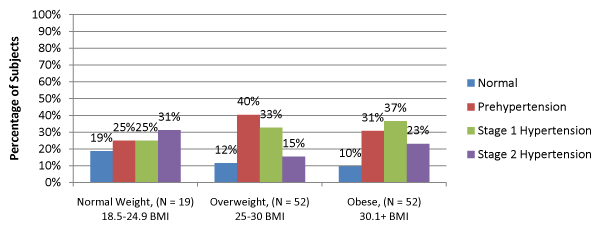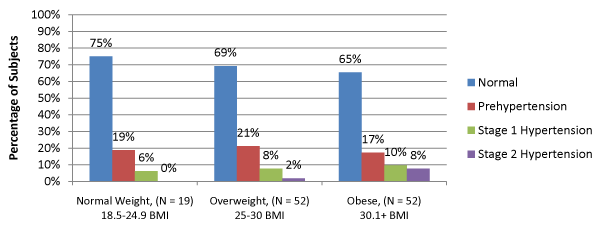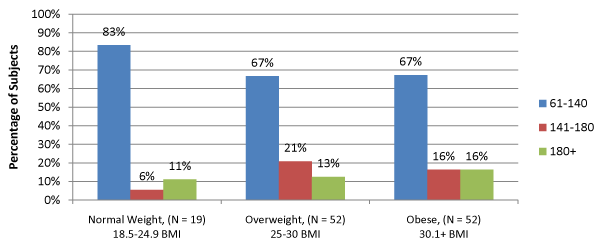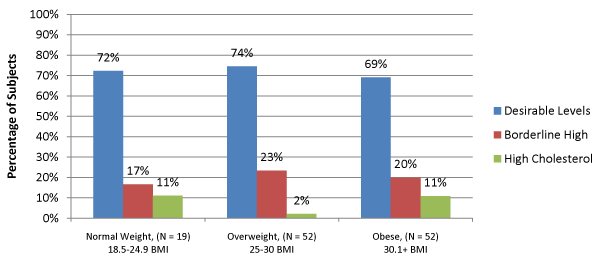Research Article Open Access
Overweight and Obesity among Older Adults: How should Obesity be Determined?
| Shahla Wunderlich*, Joseph Brusca and Yeon Bai | |
| Department of Health and Nutrition Sciences, Montclair State University, Montclair NJ 07043, USA | |
| Corresponding Author : | Shahla M. Wunderlich, Ph.D, RD Professor of Nutrition and Food Science Montclair State University, Montclair, NJ 07043-1624, USA Tel: 973-655-4373 Fax: 973-655-7042 E-mail: wunderlichs@montclair.ed |
| Received July 24, 2012; Accepted September 24, 2012; Published September 26, 2012 | |
| Citation: Wunderlich S, Brusca J, Bai Y (2012) Overweight and Obesity among Older Adults: How should Obesity be Determined? J Obes Wt Loss Ther 2:147. doi:10.4172/2165-7904.1000147 | |
| Copyright: © 2012 Wunderlich S, et al. This is an open-access article distributed under the terms of the Creative Commons Attribution License, which permits unrestricted use, distribution, and reproduction in any medium, provided the original author and source are credited. | |
Visit for more related articles at Journal of Obesity & Weight Loss Therapy
Abstract
Body Mass Index (BMI) is a common tool used to determine whether an individual is obese. The key question about obesity is whether it has any relationship to health problem as measured by common health markers. The purpose of this study therefore, is to examine whether BMI screenings are an accurate tool to measure the health status of older adults. Basic health marker screenings were performed from 123 free living older adults in New Jersey. Their health markers for blood pressure, blood sugar, and cholesterol were compared with their BMIs to determine if there was a direct correlation. These results were compared with existing literature on BMI screenings in older adults. The trend of health markers between BMI categories was similar (p > 0.05). Being overweight or obese did not necessarily show undesirable health markers. Therefore, BMI should not be used as the only tool in determining the health, obesity, and functionality of older adults.
| Keywords |
| BMI; Obesity; Elderly; Older adults; Malnutrition; Functionality; Mortality |
| Introduction |
| Obesity on the rise |
| It is expected that the number of obese older adults will increase in the coming years [1]. A medical expenditure panel from the Department of Health and Human Services estimated that in 2002, approximately 36.2% of older adults (55+) were overweight and 23.3% were obese [2]. By estimates of previous studies, it was expected that the obesity rates of older adults would reach 37.4% in 2010, an increase from 32% in 2000 [3]. A 2009-2010 report by Centers for Disease Control and Prevention revealed that 39.7% of older adults (60+) were obese [4]. However, the most recent report in the Journal of American Medical Association (JAMA) indicated that in 2009-2010, the prevalence of obesity based on Body Mass Index (BMI) was 35.5% among adult men and 35.8% among adult women, with no significant change compared with 2003-2008 [5]. All of these reports show that more than 1/3 of American adults are classified as obese. |
| Obesity is linked to many chronic diseases; the result is a lower quality of life for many older adults. These diseases include but are not limited to: type 2 diabetes, hypertension, cancer, osteoarthritis, and coronary heart disease [6]. Aside from chronic diseases, obesity in older adults has also been linked to a loss of mobility and thus a loss of independence. Obesity in combination with low muscle strength in the elderly years has been shown to cause difficulty walking and greater risk in physical disability [7]. |
| In addition to a lower quality of life, overweight older adults pose a much greater financial burden to the health care system. Some figures estimate that obese elderly men and women have 6-17% greater health care expenditures than those of a normal weight [8]. Other figures estimate that obesity is associated with a 37.4% increase per year in an individual’s health care costs [9]. A panel from the Department of Health and Human Services estimated approximately $1845 greater medical expenditures annually when comparing obese older adults to those of a normal weight [2]. As one might imagine, this places great strain on individuals, companies, charities, and government programs that provide medical care for the elderly. |
| Today, measuring height and weight and then calculating Body Mass Index (BMI) is the primarily method used to determine obesity. While this is a valuable measure, other factors such as body composition, fat distribution and movement assessment are important to include in a complete diagnosis of obesity. It is therefore, imperative that health professionals and academic researchers be engaged in determining the most accurate set of tools (not only BMI) to assess overweight and obese individuals and to work to mitigate this widespread disorder. So the main question remains whether BMI alone results in an incomplete diagnosis of obesity for older adults? Perhaps any statistics regarding the prevalence of obesity are misleading if the BMI was the sole tool for the diagnosis of obesity. This paper therefore, investigates relationships between BMI and some common biomarkers as the function of the health status among free-living elderly. |
| BMI relationship to health status |
| It has been a common practice to use BMI as the tool to screen the elderly for nutrition risk factors, obesity, morbidity and mortality. This practice can be debated because BMI is strictly calculated by an individual’s height and weight ignoring higher and lower levels of muscle mass in men and women and accuracy of height measurements among the elderly. There are published studies which have compared the relationship between BMI, body composition and mortality among older adults in a nursing home and that have found that fat-free body mass and skeletal muscle mass indexes are far better predictors than BMI for 1-year mortality estimation [10]. A study among Asian elders found similar results, that lean mass index is a better predictor of mortality than BMI. Furthermore, in a fully adjusted regression model, no association was found between BMI levels and risk of mortality when BMI and body cell mass, were compared in a 4-year all-cause mortality risk in older nursing home residents [11,12]. |
| On the other hand, some studies have shown that BMI levels correlate with body fat and with future health risks [13,14]. High BMI can predict future morbidity and death. Therefore, BMI is considered an appropriate measure for screening for obesity and its health risks. It is evident that some studies have found risks associated with higher BMIs while others have found the contrary. This implies that BMI alone should not be considered a consistent screening tool when it comes to assessing the health, wellbeing, and nutritional risk of the elderly. Furthermore, to determine the obesity in older adults poses some challenges as the tools available, specifically the most common measurement, BMI, may not be as accurate assessment as it was thought to be. Older adults’ height decreases with age. Weight can be inaccurate; because the loss of muscle mass, known as sarcopenia, is very common among elderly. Therefore, weight cannot be an independent measurement to determine BMI. At the same time the elderly often gain more fat tissues. This is commonly observed in elderly adults who suffer from obesity as their muscle mass decreases while they gain fat [15]. |
| The purpose of this preliminary study is to examine the relationship between BMI, as a tool for measuring the degree of obesity and health status of older adults. This study was done by examining the literature as well as evaluating the relationship between BMI and some common biomarkers in a group of older adults who participated in nutrition education, counseling and exercise programs. |
| Methods |
| All adults 60 years of age and over, regardless of income, are entitled to participate in the Elderly Nutrition Program (ENP). A total of 123 free-living adults age 60 and over who participated in the government programs for nutrition education, counseling and exercise, conducted at the congregate meal centers, were included in this study. The inclusion criteria were that the participants were healthy enough to come to the centers and were permitted by their physicians to participate in exercise programs. |
| This study falls under the scope of an approved Montclair State University Institutional Review Board (IRB) protocol. The study followed the protocol for human participants, i.e., disclosing the purpose of the study and other pertinent information. Informed consent was obtained from participants prior to the study. Each participant received a risk evaluation form and doctor approval prior to receiving exercise training. |
| Demographic data (age, gender, ethnicity, marital status, socioeconomic status and education), anthropometric measurements (height, weight, and BMI = Kg/m2), and medical history (medical conditions) were obtained from the participants. The BMI was calculated by measuring the height and weight of each participant. The medications taken by the participants were also recorded. Registered nurses measured key health parameters such as blood pressure, cholesterol, and glucose for monitoring the health status. |
| Results |
| The mean age of all participants was 74.33 ± 8.50 years with majority of participants being women (74.6%). The racial composition of the population in this study and the county where it took place were mostly Caucasians (42.9%) followed by African Americans (28.6%). Over half of the participants lived alone (55.1%) and 68.1% were not married at the time of the study. The majority of participants had received a high school education (60.9%) followed by 29% college, 8.7% middle school and only 1.4% did not have any formal education (Table 1). A large number of participants were reported having one or more medical conditions, with heart disease and high blood pressure being the primary medical problems. Approximately 40% of subjects reported taking 3 or more medications, mostly for blood pressure. Some participants chose not to provide certain demographic information such as income level. Those participants who chose to provide their income fell at or below the poverty line. Most participants were overweight, with calculated BMI of 28.26 ± 4.9. |
| This preliminary study revealed no statistically significant correlation between BMI and the tested health markers. However, there were some average trends which the authors deemed noteworthy (Figures 1-4). Those classified in the “obese” category for BMI (30.1+) were less likely to have normal diastolic blood pressure than the overweight and normal participants (65%, 69%, 75%, respectively). The overweight and obese participants as classified by BMI were also less likely to have normal blood sugar levels than those who were of a normal BMI (67%, 67%, 83%, respectively). Interestingly, those with the highest BMIs were more likely to have desirable cholesterol levels compared to the other categories, (72%, 74%, 69%; Normal Weight, Overweight, and Obese). A potential explanation for this is the common use of cholesterol lowering medications among this group. |
| Discussion |
| Previous studies done with BMI in the literature have yielded inconsistent results as to whether can be considered to be an accurate measure of health risk in older adults. One study [16] with 2,334 elderly subjects found strong associations between BMI and some nutrition related health ailments including chronic heart diseases, stroke, and peripheral artery disease [16]. Another study that examined 5200 elderly individuals (ages 65 and over) found that there was an inverse relationship between BMI and mortality. Body Mass Index was found to be a negative predictor of mortality whereas waist circumference (WC) was found to be a positive predictor of mortality [17]. |
| The U-Shaped curve as classified by Zunzunegui et al. [18], indicates that mortality’s relationship to BMI can be seen at the extreme ends of the spectrum. In this particular study, the lowest mortality rate was ~30.0 BMI, a number which is considered obese by the NIH [18]. The mortality rate of the subjects increased drastically when their BMI was below 25 and above 35. |
| As previously stated, BMI cannot adequately account for lean muscle mass. A study done with 877 Asian elderly participants found no correlation between BMI and mortality once they adjusted for other variables (Smoking, exercise, cholesterol, etc). However, they did find a correlation between lean muscle mass and lower mortality rates. Because this study was only done on Asians who have a different body type than other population groups, the findings may not be able to be generalized although they are conflicting with one previous study cited above which was also with an Asian population [11]. |
| Interestingly, another study found an association between higher BMI and functional status. Despite this, the study also found that elderly people with higher BMIs had a risk for malnutrition [19]. These risks were calculated by using their ADL (Activities of Daily Living) IADL (Instrumental Activities of Daily Living) scores. Therefore, it is suggested that malnutrition be considered and screened for despite the BMI of an elderly individual. |
| Consequently, many researchers indicate that the BMI should be used with other easy and simple tools such as waist circumference to identify body fat distribution. Although, some consider BMI as a good measure of total body fat but not fat distribution it still has its limitations. Measurements such as waist circumference could be a better measurement for determining fat distribution and abdominal fat. The limitations of BMI should be considered when it is used as a sole diagnosis tool. Many factors, specifically in older adults, such as age, gender, ethnicity, hydration, and muscle mass, to name a few, can influence the relationship between BMI and body fat. The weight parameter in the BMI index does not differentiate between excess fat, muscle, or bone mass, nor does it provide any indication of the distribution of fat within individuals. The Department of Health and Human Services and Centers for Disease Control and Prevention, discuss the BMI considerations for practitioners at their website [20]. A new index called “A Body Shape Index,” or ABSI has been developed which uses waist circumference (WC) as a risk indicator supplementary to BMI and is considered a better indicator of health and mortality [21]. |
| Conclusion |
| While BMI can be useful for quick screening to diagnose extreme and urgent risks, nutrition assessments and other tests should be done in order to truly diagnose health risks in the elderly. Both the scientific literature and this study indicate that BMI may not be an accurate way to diagnose metabolic diseases, functionality, mortality rates, or malnutrition. As previously stated, this is most likely the case because BMI does not necessarily have a linear relationship with obesity because muscle mass and height can be maintained or lost at varying rates in different individuals. Screenings such as waist circumference and lean body mass screenings may be more accurate in determining health risks that exist for the elderly. However, it is still clear that at the extreme ends of the spectrum (below 25 or above 35). BMI can alert health providers that there is a reason for concern. In conclusion, BMI screenings should be read with caution for the elderly, as they may not necessarily be indicative of their obesity, health, or functionality status. Because BMI cannot measure body fat precisely and distinguish health from disease or risk of disease, it should serve as an initial screening of overweight and obesity for adults. Further information is needed to better understand the correlation of BMI, body fatness, fat distribution, health status, and various diseases. Health care providers should recognize that other factors such as fat distribution, age, gender and genetics among other factors, should be considered for a complete assessment of health status and disease risk. |
| Acknowledgements |
| Authors would like to acknowledge Michelle O’Malley for her assistance in administrating the programs for the elderly. |
References
- Wang YC, Colditz GA, Kuntz KM (2007) Forecasting the obesity epidemic in the aging US population. Obesity 15: 2855-2865.
- Rhoades JA (2005) Overweight and obese elderly and near elderly in the United States, 2002: estimates for the noninstitutionalized population age 55 and older. Medical Expenditure Panel Survey.
- Arterburn DE, Crane PK, Sullivan SD (2004) The coming epidemic of obesity in elderly Americans. J Am Geriatr Soc 52: 1907-1912.
- Ogden CL, Carroll MD, Kit BK, Flegal KM (2012). Prevalence of obesity in the United States, 2009–2010. NCHS Data Brief :1-8
- Flegal KM, Carroll MD, Kit BK, Ogden CL (2012) Prevalence of obesity and trends in the distribution of body mass index among US adults, 1999-2010. JAMA 307: 491-497.
- http://www.who.int/mediacentre/factsheets/fs311/en/
- Stenholm S, Alley D, Bandinelli S, Griswold ME, Koskinen S, et al.(2009). The effect of obesity combined with low muscle strength on decline in mobility in older persons: results from the inCHIANTI study. Int J Obes 33: 635-644.
- . Yang Z, Hall AG (2008) The financial burden of overweight and obesity among elderly Americans: The dynamics of weight, longevity, and health care cost.Health Serv Res 43: 849-868.
- Finkelstein EA, Fiebelkorn IC, Wang G (2003) National medical spending attributable to overweight and obesity: How much, and who’s paying? Health Aff W3: 219-226.
- Kimyagarov S, Klid R, Levenkrohn S, Fleissig Y, Kopel B, et al. (2010) Body mass index (BMI), body composition and mortality of nursing home elderly residents. Arch Gerontol Geriatr 51: 227-230.
- Han SS, Kim KW, Kim KI, Na KY, Chae DW, et al.(2010) Lean mass index: A better predictor of mortality than body mass index in elderly Asians. J Am Geriatr Soc 58: 312-317.
- Volpato S, Romagnoni F, Soattin L, Blè A, Leoci V, et al.(2004). Body mass index, body cell mass, and 4-year all-cause mortality risk in older nursing home residents. J Am Geriatric Soc 52: 886-891.
- Bigaard J, Tjønneland A, Thomsen BL, Overvad K, Heitmann BL, et al. (2003) Waist circumference, BMI, smoking, and mortality in middle-aged men and women. Obes Res 11: 895–903.
- Janssen I, Heymsfield SB, Allison DB, Kotler DP, Ross R (2002) Body mass index and waist circumference independently contribute to the prediction of nonabdominal, abdominal subcutaneous, and visceral fat. Am J Clin Nutr 75: 683–688.
- Li Z, Heber D (2012) Sarcopenic obesity in the elderly and strategies for weight management. Nutr Rev 70: 57-64.
- He Y, Jiang B, Wang J, Feng K, Chang Q, et al (2007) BMI versus the metabolic syndrome in relation to cardiovascular risk in elderly Chinese individuals. Diabetes Care 30: 2128-2134.
- Janssen I, Katzmarzyk PT, Ross R (2005) Body mass index is inversely related to mortality in older people after adjustment for waist circumference. J Am Geriatr Soc 53: 2112-2118.
- Zunzunegui MV, Sanchez MT, Garcia A, Casado JM, Otero A (2012) Body mass index and long-term mortality in an elderly Mediterranean population. J Aging Health 24: 29-47.
- Bahat G, Tufan F, Saka B, Akin S, Ozkaya H, et al. (2012) Which body mass index (BMI) is better in the elderly for functional status? Arch Gerontol Geriatr 54: 78-81.
- http://www.cdc.gov/obesity/downloads/BMIforPactitioners.pdf
- Krakauer NY, Krakauer JC (2012) A new Body Shape Index predicts mortality hazard independently of Body Mass Index. PLoS ONE 7: e39504.
Tables and Figures at a glance
| Table 1 |
Figures at a glance
 |
 |
 |
 |
| Figure 1 | Figure 2 | Figure 3 | Figure 4 |
Relevant Topics
- Android Obesity
- Anti Obesity Medication
- Bariatric Surgery
- Best Ways to Lose Weight
- Body Mass Index (BMI)
- Child Obesity Statistics
- Comorbidities of Obesity
- Diabetes and Obesity
- Diabetic Diet
- Diet
- Etiology of Obesity
- Exogenous Obesity
- Fat Burning Foods
- Gastric By-pass Surgery
- Genetics of Obesity
- Global Obesity Statistics
- Gynoid Obesity
- Junk Food and Childhood Obesity
- Obesity
- Obesity and Cancer
- Obesity and Nutrition
- Obesity and Sleep Apnea
- Obesity Complications
- Obesity in Pregnancy
- Obesity in United States
- Visceral Obesity
- Weight Loss
- Weight Loss Clinics
- Weight Loss Supplements
- Weight Management Programs
Recommended Journals
Article Tools
Article Usage
- Total views: 7537
- [From(publication date):
September-2012 - Jul 05, 2025] - Breakdown by view type
- HTML page views : 2837
- PDF downloads : 4700
